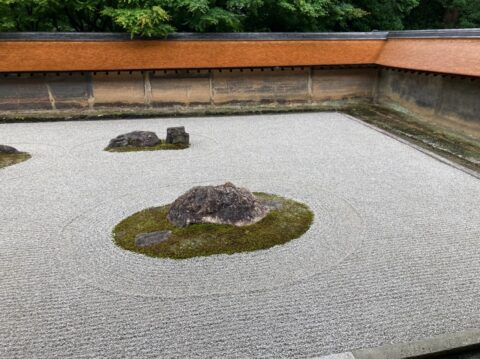
Download
Veranstaltungsort
DIJ Tokyo (access)
Anmeldung
This is a past event. Registration is no longer possible.
DIJ Mailing List
Please subscribe below to stay informed about our research activities, events & publications:
The Sublime and Wabi-Sabi
29. Juni 2023
Philippe Bürgin, State University of Fine Arts Stuttgart/DIJ Tokyo
One of the most noteworthy examples of the Japanese art form known as karesansui (枯山水), i. e. dry landscape garden, can be found at the Ryōan-ji in Kyoto. The dry landscape garden at the Ryōan-ji intrigues the spectator with its abstract and sparse composition of rocks and moss on an otherwise empty field of raked gravel. The garden’s abstract composition has furthered many symbolic and structural interpretations that allow for example many insights into Zen philosophy, but it has yet to provide insights into its aesthetic appeal. I would like to propose that the aesthetic appeal of this garden’s composition can be fruitfully recontextualized in accordance with the aesthetic category of the Kantian sublime. There is an argument to be made that Japanese art forms such as the karesansui go beyond what could traditionally be understood as beautiful or fine arts; they are sublime arts in the sense that their abstract moments point towards a void, an idea, something that goes beyond our perception – but still within our perception. In the case of the sublime those structural moments can be identified as formlessness and presence, as an aesthetic latency and an inherent inpurposiveness to our perception. Common to all these structural moments, however, is the sublime’s feature as an aesthetic analogy to an idea. These aspects could thereby be reframed as a paradigm of aesthetics. This is to say that there are structural moments of aesthetic experiences to be found in the sublime that could give a new framework on what actually happens to the spectators if they are confronted with landscapes, artworks and other cultural artefacts. The aesthetic moments of the sublime thereby coincide with Japanese aesthetic categories such as wabi-sabi in the important aspects that they mark the spatial and temporal thresholds of what is representable. This presentation argued that there is a latent sublimity to Japanese art works in which even modern forms of artistic expression might have been anticipated.
Philippe Bürgin has been a doctoral student in the field of Aesthetics at the State University of Fine Arts Stuttgart since 2022. The main focus of his doctoral thesis is on the Kantian aesthetics of the sublime as a systematic paradigm of aesthetic experiences. His current research project at the DIJ proposes that on the basis of Japanese aesthetics, the sublime could constitute a framework for a deeper intercultural understanding of the inner workings of aesthetic experiences. Philippe has been a PhD Student at the DIJ since March 2023.